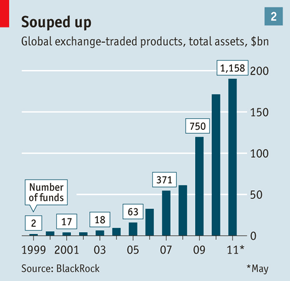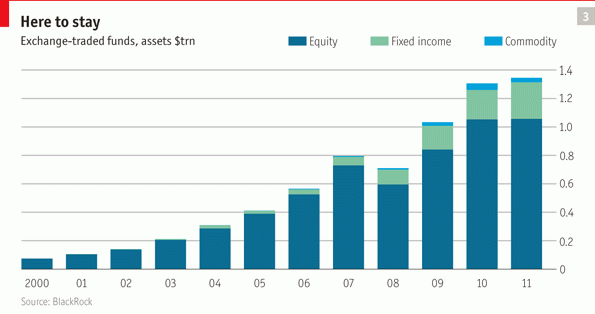The second great financial innovation of the last 20 years
Posted on December 11, 2013Paul Volcker, head of the US Federal Reserve in the early 1980s said as recently as 2009 that the only useful financial innovation in the last 20 years was the ATM. He was mostly right since a lot of nonsense passed for innovation over the last 10 years. However we think he forgot a second innovation, which has made life a lot easier for the average investor. That is the invention of the exchange traded fund, called an ETF. This has changed the game over the last 5 years, not just for investors, but also poses a challenge to many so called advisers.
To understand why ETFs are such a great innovation, it helps to understand the choices and problems that faced the average investors before ETFs. There were considerable problems that investors faced in the 70’s, 80’s and even 1990’s in investing safely.
Before ETFs the average investor had two main options in share investing. The first was to build their own share portfolios, which were time-consuming, tricky and risky if done poorly. The second was to buy mutual funds, usually through a salesman, that would require an application form and probably a commission. Mutual funds also had significant management fees of 1.5% per annum in addition to the bid-offer spread, which also reduced returns. Neither was a great solution since the majority of mutual fund managers tended to do rather poorly and the paperwork was a pain.
Vanguard launches Index Funds
Not all mutual funds did badly and charged too much. Vanguard, launched by John Bogle was an exception and launched the index fund industry back in 1976. Derided or ignored by mutual fund managers, for obvious reasons, Vanguard was a slow but ultimately huge success. Low cost funds that track indexes were a huge advance for the average investor. There were also attractive to pension and professional money managers.
Still, mutual funds dominated
You might think that an investment method that can prove it performs better would kill its competition. But you’d be wrong. Vanguard did very well to be sure, and ultimately many companies copied their strategy. Still active strategy mutual funds thrived. Active mutual funds still remain the bulk of assets under management, even today, particularly in countries outside the United States.
Why can’t I buy an index fund through a stock market account?
Ultimately it was the Canadians that launched the first fund that was traded on an exchange. It was called the TIP 35 and launched on the Toronto Stock Exchange way back in 1989. Few people remember that since the Canadians however, for whatever reason, failed to develop their new toy and it was America that truly launched the ETF industry in 1993.
The first ETF was called SPDR
The first American ETF was based on a Standard and Poor’s 500 Index and launched by State Street. Its ticker was “SPDR”; hence the name “spider” was coined for the ungainly acronym. All of the early ETFs were index linked and this remained true for many years, until fairly recently. You can also buy this ETF even today with the ticker SPY. It has $160 Billion under management (that’s a sterling success) probably attracted in part by its very low cost per annum of just 0.05%, no purchase costs and the fact that it matches a very popular index, the S&P500 very very well. Its error in tracking the index is barely a few points of a percentage per year. It’s nigh perfect.
A slow birth
Still, even with all the advantages of ease of purchase and lower cost, it took a while to gather steam. In fact by 2000 still only 2 ETFs existed. Even as recently as 2005, barely 63 were on offer. That’s not a big range. During my post graduate finance study in 2004 ETFs weren’t even mentioned. Not once. The curriculum for CFA, even now, continues to devote only a part of a small chapter to ETFs and labels them with the somewhat pejorative term “alternative investments”.
Not that alternative any more
ETFs however have quickly become very main stream. As the market realized the usefulness of the innovation over the last 7 years, it truly has taken off and growth has, despite the financial crisis, become exponential. We’d also argue that low cost online brokerage accounts that pushed commissions from $30-40 per trade to $10 or even less also helped ETFs win acceptance.
ETFs and Discount Online Brokers – A Perfect Match
The combination of a low cost brokerage account and ETFs is a powerful and liberating fact for the average investor at home. We don’t think it is a co-incidence that the United States is home to both the most number of ETFs and also the best range of discount brokerage options.
To market professionals and experienced investors, the benefits of ETFs are clear and are worth restating again.
Benefits:
- Diversification – is far easier than buying a huge number of shares yourself.
- Costs – are far lower than most mutual funds
- Easy – just buy through a brokerage account. No forms required.
- Segmentation – you can now buy income, commodity and thousand other flavors.
So where to from here?
The goal for this blog is to help teach people how to invest. If you have the time, patience and drive, then you should be assisted. So we will have a running series of articles on ETFs, some examples, discussions on key points and how to use them in your portfolio. Stay tuned.
About Caterer Goodman Partners
Caterer Goodman Partners is a Shanghai based wealth management firm established with a clear vision to provide a new level of personalized financial planning services for expatriates in Asia. Our financial advisors provide guidance for our clients in all areas of investment, specialising in managed accounts, money-market funds, retirement planning and alternative investments. At Caterer Goodman Partners, we offer our advice and experience to provide low cost, tax-effective and simple solutions to match our clients’ interests.
About Owen Caterer
Since graduation Mr Owen Caterer has worked with the Queensland Premier's Department in Trade Facilitation and then as a financial adviser in Shanghai from 2005 until 2010. He then rose to Senior Adviser, then Business Development manager and then to Chief Investment Officer responsible for portfolios to a value of US$280 million across Asia. Following that Mr Caterer left to found his own firm with a partner in the financial advisory and wealth management area. This focused on developing China and Asia's first fee-based financial advisory (rather than commission-based). This has grown to now have 8 staff and and managing almost US$35 million for clients throughout Asia. This business success was recognized as a finalist in the 2013 ACBA in the Start Up Enterprises category and are one of a small number of foreign managed firms to have a full asset management license in China. Owen has also been active in the community volunteering for the Australian Chamber of Commerce in Shanghai and acting as the Vice-Chair of the Small Business Working Group (2012-2014) and as the Co-Deputy Chair of the Financial Services since 2013 until the present. They have continued to grow their business and have now been selected as a small group of companies who are platinum members of the Australian chamber of commerce. The achievement they are most proud of is their efforts to reform the financial planning industry in China and push it away from a hard-sales commission driven model to a more ethical management fee and long term customer service model. Owen has a Graduate Diploma of Applied Finance from the Securities Institute of Australia of which he was a member as a Fellow of Finance for many years and also has an undergraduate degree from Griffith University in International Business. Owen's interests are tennis, running and his wife and two children. He speaks fluent Chinese, first arriving in China in 1997.
Tags: 2013, Advice, Caterer Goodman, Chinese Funds, ETF, Expat
Categorised in: ETF's, Investments



